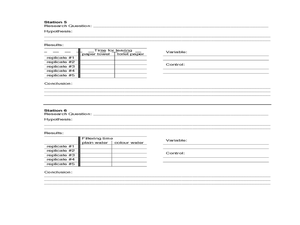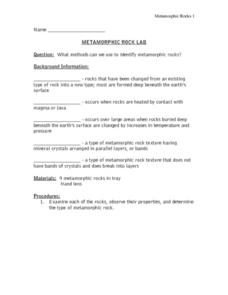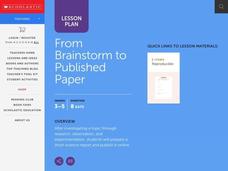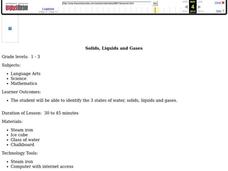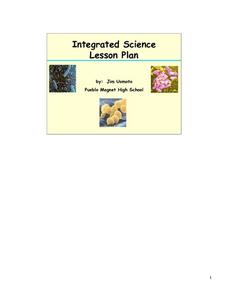Curated OER
How Can Humans Change Ecosystems?
In this ecosystems worksheet, students complete a graphic organizer by writing in 2 facts and 1 conclusion about how humans change ecosystems.
Curated OER
Molar Ratio
Students conduct an experiment in which they react sodium bicarbonate with hydrochloric acid to determine the molar ration between the two reactants. Students must write correct formula and a balanced chemical equation and explain how...
Curated OER
Graphing Sound
Students formulate an understanding of sound as a vibration and draw their graph as carefully as possible on their observation sheet. They also record how they made the sound and and a description of the sound. Finally, students cut out...
Curated OER
What Boat Designs Float the Best?
Fifth graders investigate buoyancy by conducting a science experiment. In this water properties lesson plan, 5th graders predict which of their different paper boat designs will float for the longest period. Students conduct...
Curated OER
The Scientists’ Way
Students summarize the steps of the scientific method. For this life science lesson, students explain the importance of varying only one variable at a time. They analyze possible flaws in their experiment.
Curated OER
Production of Hydrogen
Students generate hydrogen gas and examine some of its properities through an experiment. In the experiment, a wood splint is lit along with a candle, then the reaction occurs within the mixture. There are questions for the student to...
Curated OER
How Are Weather Forecasts Made?
In this weather worksheet, students complete a graphic organizer by writing in the different types of air masses and what types of weather are created by these different air masses.
Curated OER
Metamorphic Rock Lab
For this metamorphic rock worksheet, students observe 9 metamorphic rock samples and indicate the grain size, if there are bands, if there are layers , if it is foliated and they identify the name of the rock. They complete 5 sentences...
Curated OER
Domino Dash
In this speed worksheet, students use dominoes to measure the average speed of rows falling over. Students make a line graph to show the relationship between the length of the domino row and the time. Students answer 8 questions about...
Curated OER
From Brainstorm to Published Paper
Students investigate a topic through research, observation, and experimentation. They prepare a short science report and publish it online. Students reflect on the role of science reports in the larger scientific community.
Curated OER
How is Sound Made?
In this sound worksheet, students will fill in the blank of 4 facts based on what sound different objects make. Based on those facts, students will write in a conclusion about how sound is made.
Curated OER
What is Thermal Energy?
In this thermal energy worksheet, students will write down two facts about thermal energy and then they will draw a conclusion based on these two facts.
Curated OER
Create a Cloud in a Bottle
Learners observe an experiment showing the formation of a cloud. They write a paragraph summarizing the condition that are necessary for a cloud to form and explain the weather situations cause cloud formation.
PBS
Predicting/Making a Hypothesis
As an introduction to the hypothesis and testing method of investigation, young history detectives engage in a special investigation of a family artifact. After watching a short video that demonstrates the method, they develop a...
Code.org
The Need for Algorithms
Pairs work through two scenarios that require them to generate an algorithm. The first activity requires pairs to define a common language to use; the second comes with the language. The pairs then must determine how to code the...
Population Connection
The Carbon Crunch
Carbon is in the air; should we care? Teach the class why it is important to pay attention to carbon levels and how the world population and various countries across the globe affect the carbon levels in the atmosphere. High schoolers...
Channel Islands Film
Arlington Springs Man: Lesson Plan 1
Learning to craft quality questions is a skill that can be taught. Class members use the Question Formulation Technique to learn how to create and refine both closed-ended and open-ended questions. They then view West of the West's...
Curated OER
Examine the Data
Seventh graders examine a teacher-created database and identify specific variables and develop hypothesis statements as to their possible effect. They create a summary statement either proving or disproving their hypothesis.
Curated OER
Enzymes and Catalysts
Students discuss the functioning of the digestive system and the specific enzymes present. They observe the action of amylase on starch to identify characteristics of enzymes then perform an experiment on the effects of temperature on...
Curated OER
Solids, Liquids and Gases
Students explore solids, liquids, and gases. For this states of water lesson, students conduct a scientific investigation that requires them to observe and note the differences among solid, liquids, and gases.
Central Bucks School District
Igneous Rocks Lab
Searching for a simple igneous rocks experiment to assist pupils with rock classification based on texture and composition? In the activity, pupils view multiple rocks in various ways to determine texture and composition. They then...
Curated OER
Color Mixing
Students experiment with primary colored water to mix new colors. They record new colors on a simple data sheet and share opinions on their work.
Curated OER
What Should I Know About Photosynthesis
This four-page handout would work great as a reading guide or note-taking resource for teens learning about ATP, photosynthesis, the key scientists in the realm of photosynthesis, and more. It is designed to accompany a certain textbook,...
Curated OER
Scientific Method Unit: Bacteria
Students discover how to apply the steps of the inquiry process through the study of bacteria. Working in groups of four, they cooperatively read an article about bacteria and complete a graphic organizer. Group members share with others...




